The Pathways of Wellbeing: Primary Education and its Impact in Samoa
VerifiedAdded on 2020/04/07
|9
|1724
|60
Report
AI Summary
This report provides an executive summary of primary education in Samoa, focusing on its historical context, current status, and impact on child wellbeing. It details the involvement of parents in educational decisions, the structure of the Samoan education system, and the government's efforts to improve primary education. The report discusses the status of education, its causes, and impacts on the population, including literacy rates and the influence of migration. It also explores the solutions and pathways employed, such as the Education Act of 2009, the development of bilingual curricula, and financial assistance programs like the Samoa School Fees Grant Scheme. The report concludes with recommendations to address challenges like high dropout rates and low attendance, suggesting stricter enforcement of attendance policies and increased community involvement to ensure the holistic development of Samoan children through primary education.
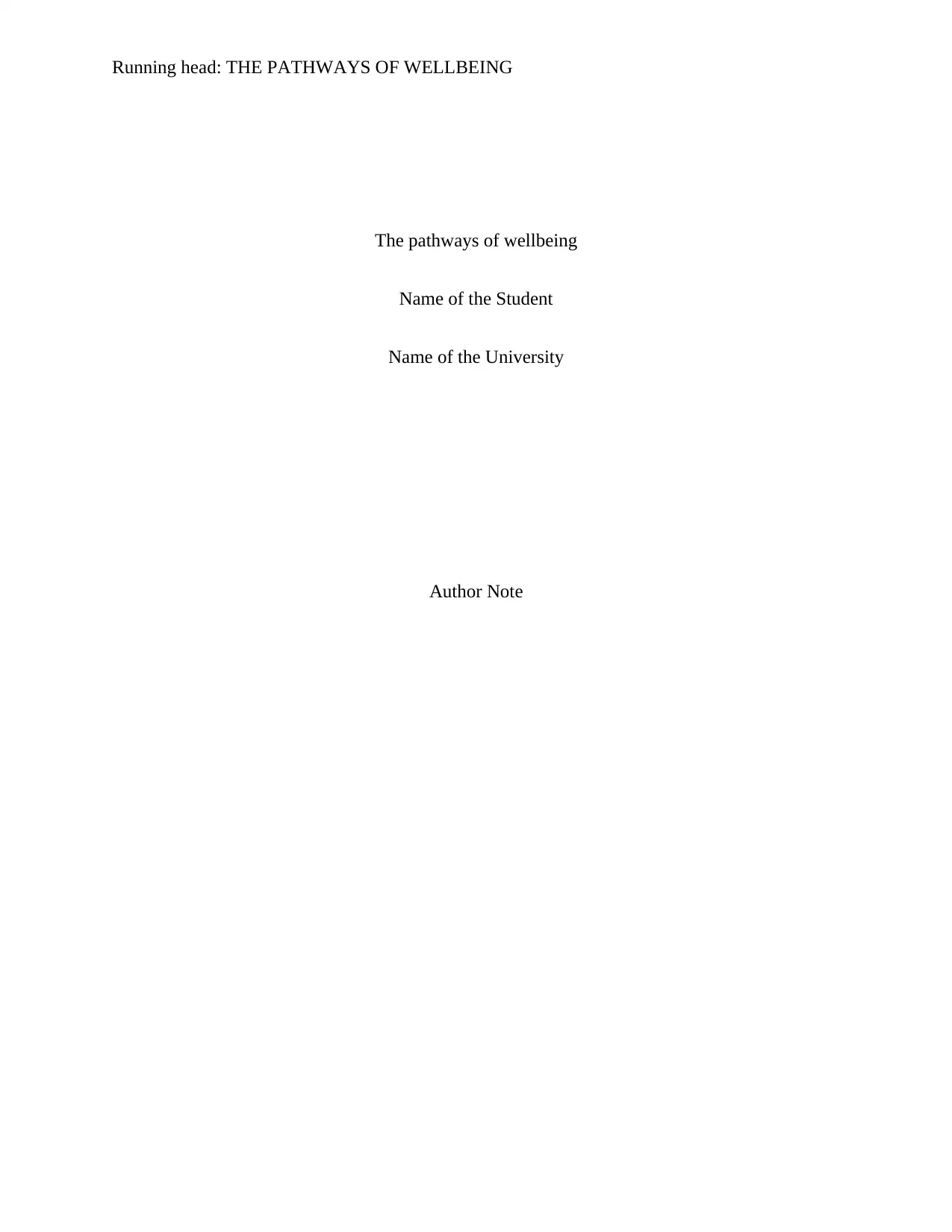
Running head: THE PATHWAYS OF WELLBEING
The pathways of wellbeing
Name of the Student
Name of the University
Author Note
The pathways of wellbeing
Name of the Student
Name of the University
Author Note
Paraphrase This Document
Need a fresh take? Get an instant paraphrase of this document with our AI Paraphraser
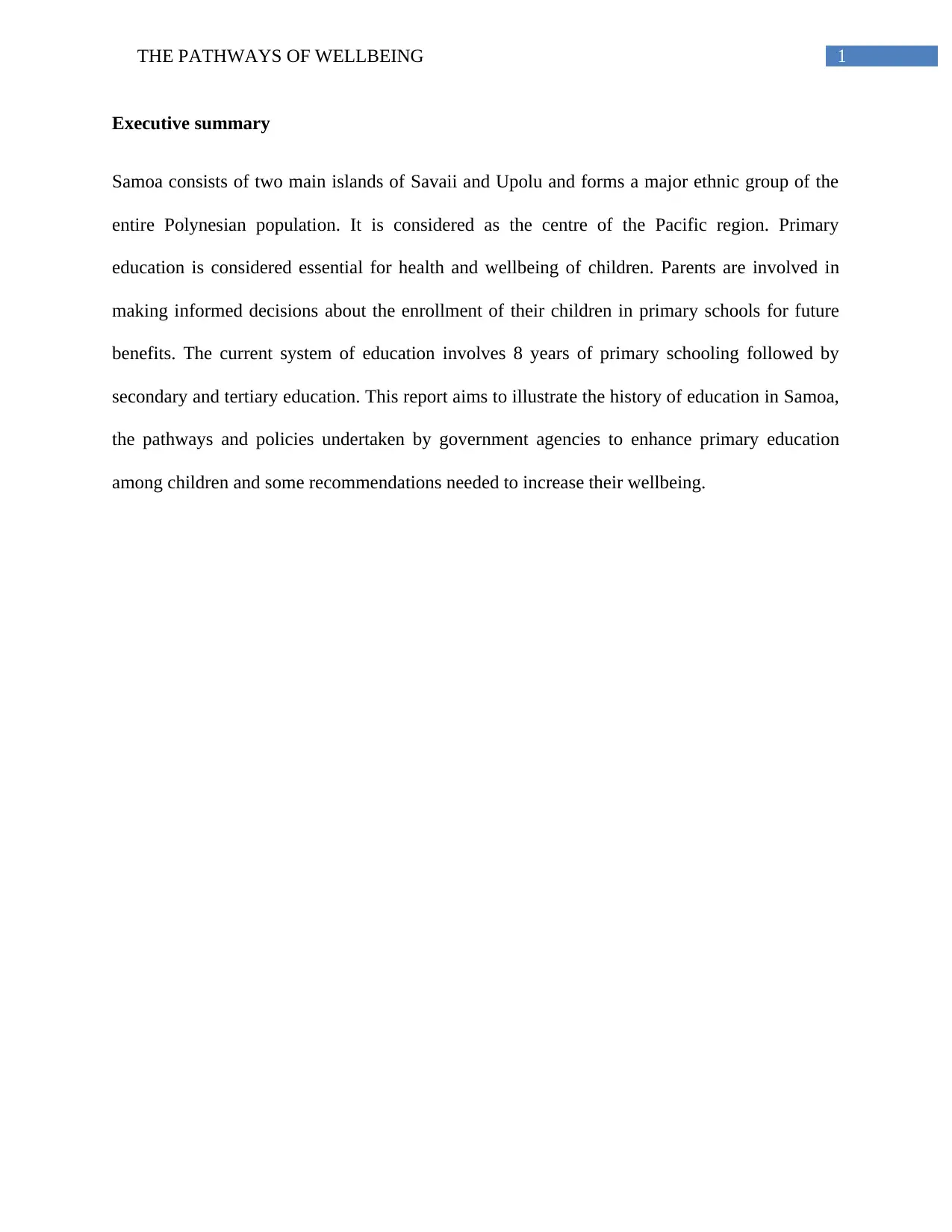
1THE PATHWAYS OF WELLBEING
Executive summary
Samoa consists of two main islands of Savaii and Upolu and forms a major ethnic group of the
entire Polynesian population. It is considered as the centre of the Pacific region. Primary
education is considered essential for health and wellbeing of children. Parents are involved in
making informed decisions about the enrollment of their children in primary schools for future
benefits. The current system of education involves 8 years of primary schooling followed by
secondary and tertiary education. This report aims to illustrate the history of education in Samoa,
the pathways and policies undertaken by government agencies to enhance primary education
among children and some recommendations needed to increase their wellbeing.
Executive summary
Samoa consists of two main islands of Savaii and Upolu and forms a major ethnic group of the
entire Polynesian population. It is considered as the centre of the Pacific region. Primary
education is considered essential for health and wellbeing of children. Parents are involved in
making informed decisions about the enrollment of their children in primary schools for future
benefits. The current system of education involves 8 years of primary schooling followed by
secondary and tertiary education. This report aims to illustrate the history of education in Samoa,
the pathways and policies undertaken by government agencies to enhance primary education
among children and some recommendations needed to increase their wellbeing.
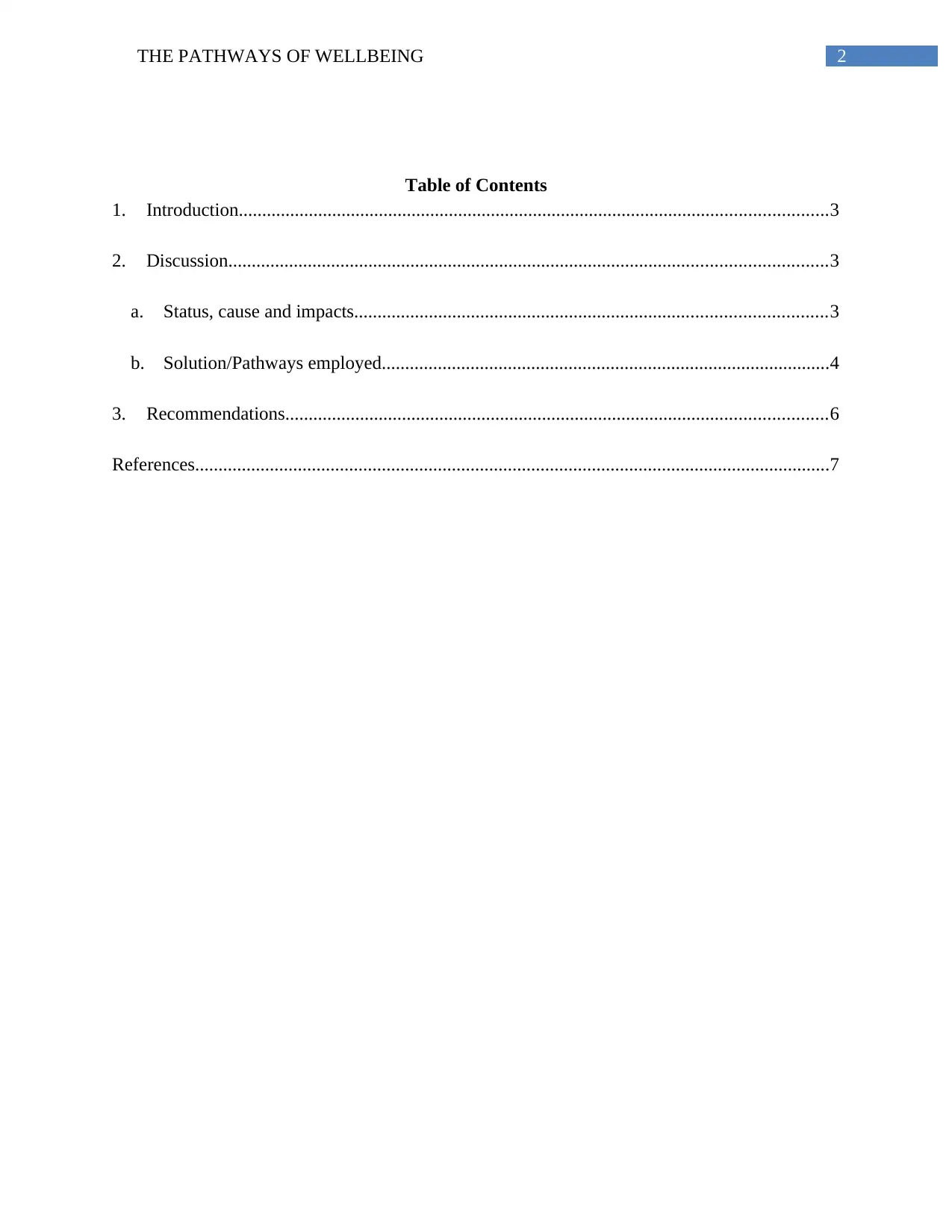
2THE PATHWAYS OF WELLBEING
Table of Contents
1. Introduction..............................................................................................................................3
2. Discussion................................................................................................................................3
a. Status, cause and impacts.....................................................................................................3
b. Solution/Pathways employed................................................................................................4
3. Recommendations....................................................................................................................6
References........................................................................................................................................7
Table of Contents
1. Introduction..............................................................................................................................3
2. Discussion................................................................................................................................3
a. Status, cause and impacts.....................................................................................................3
b. Solution/Pathways employed................................................................................................4
3. Recommendations....................................................................................................................6
References........................................................................................................................................7
⊘ This is a preview!⊘
Do you want full access?
Subscribe today to unlock all pages.

Trusted by 1+ million students worldwide
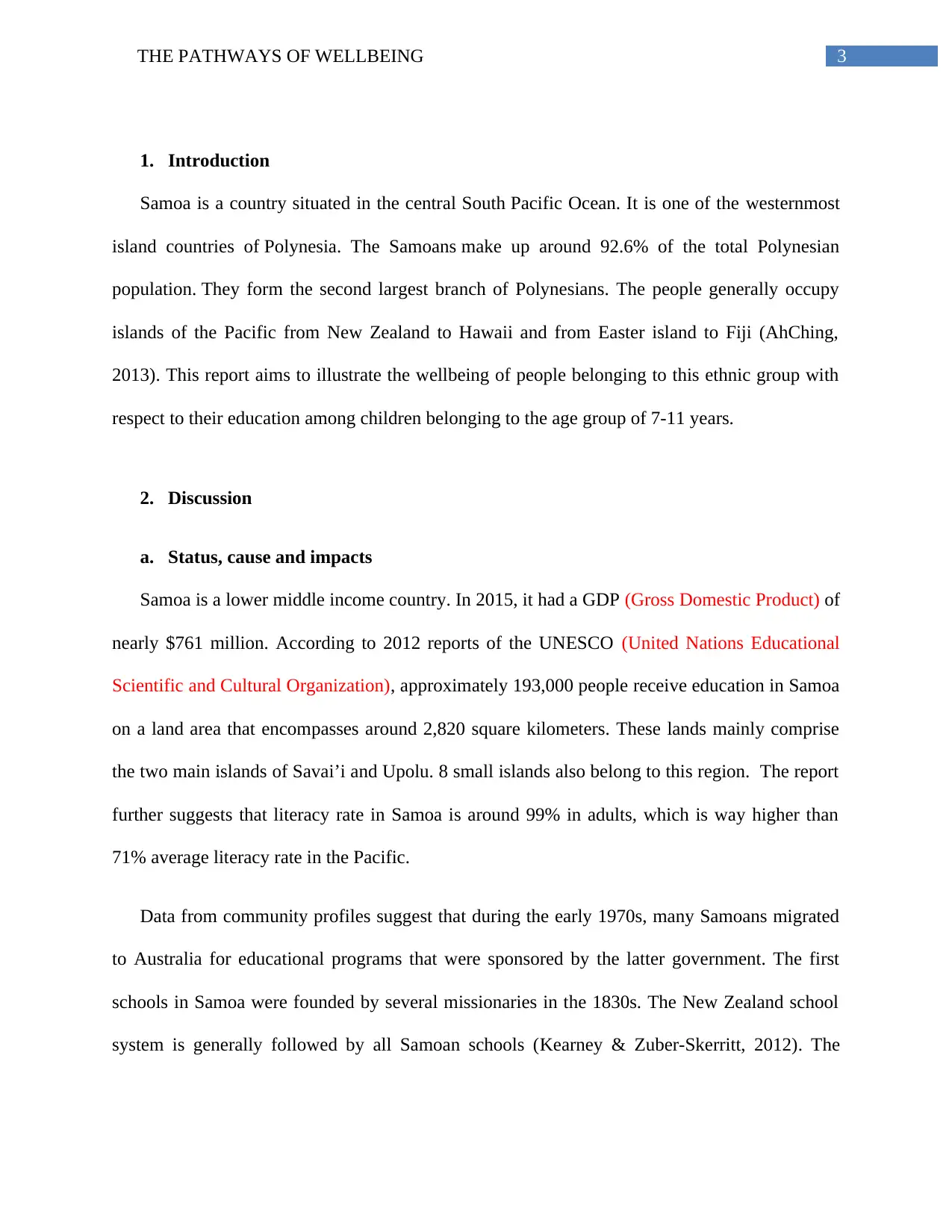
3THE PATHWAYS OF WELLBEING
1. Introduction
Samoa is a country situated in the central South Pacific Ocean. It is one of the westernmost
island countries of Polynesia. The Samoans make up around 92.6% of the total Polynesian
population. They form the second largest branch of Polynesians. The people generally occupy
islands of the Pacific from New Zealand to Hawaii and from Easter island to Fiji (AhChing,
2013). This report aims to illustrate the wellbeing of people belonging to this ethnic group with
respect to their education among children belonging to the age group of 7-11 years.
2. Discussion
a. Status, cause and impacts
Samoa is a lower middle income country. In 2015, it had a GDP (Gross Domestic Product) of
nearly $761 million. According to 2012 reports of the UNESCO (United Nations Educational
Scientific and Cultural Organization), approximately 193,000 people receive education in Samoa
on a land area that encompasses around 2,820 square kilometers. These lands mainly comprise
the two main islands of Savai’i and Upolu. 8 small islands also belong to this region. The report
further suggests that literacy rate in Samoa is around 99% in adults, which is way higher than
71% average literacy rate in the Pacific.
Data from community profiles suggest that during the early 1970s, many Samoans migrated
to Australia for educational programs that were sponsored by the latter government. The first
schools in Samoa were founded by several missionaries in the 1830s. The New Zealand school
system is generally followed by all Samoan schools (Kearney & Zuber-Skerritt, 2012). The
1. Introduction
Samoa is a country situated in the central South Pacific Ocean. It is one of the westernmost
island countries of Polynesia. The Samoans make up around 92.6% of the total Polynesian
population. They form the second largest branch of Polynesians. The people generally occupy
islands of the Pacific from New Zealand to Hawaii and from Easter island to Fiji (AhChing,
2013). This report aims to illustrate the wellbeing of people belonging to this ethnic group with
respect to their education among children belonging to the age group of 7-11 years.
2. Discussion
a. Status, cause and impacts
Samoa is a lower middle income country. In 2015, it had a GDP (Gross Domestic Product) of
nearly $761 million. According to 2012 reports of the UNESCO (United Nations Educational
Scientific and Cultural Organization), approximately 193,000 people receive education in Samoa
on a land area that encompasses around 2,820 square kilometers. These lands mainly comprise
the two main islands of Savai’i and Upolu. 8 small islands also belong to this region. The report
further suggests that literacy rate in Samoa is around 99% in adults, which is way higher than
71% average literacy rate in the Pacific.
Data from community profiles suggest that during the early 1970s, many Samoans migrated
to Australia for educational programs that were sponsored by the latter government. The first
schools in Samoa were founded by several missionaries in the 1830s. The New Zealand school
system is generally followed by all Samoan schools (Kearney & Zuber-Skerritt, 2012). The
Paraphrase This Document
Need a fresh take? Get an instant paraphrase of this document with our AI Paraphraser
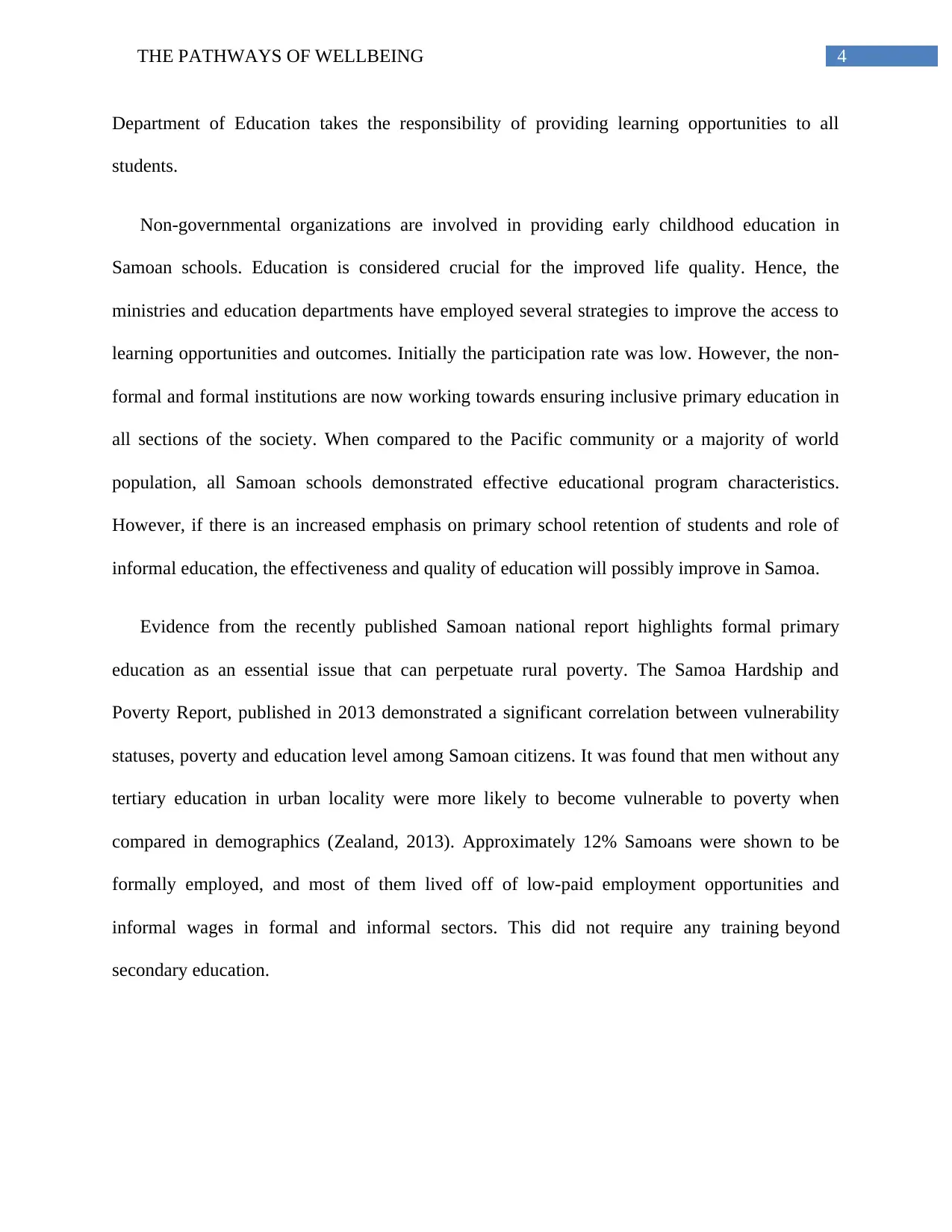
4THE PATHWAYS OF WELLBEING
Department of Education takes the responsibility of providing learning opportunities to all
students.
Non-governmental organizations are involved in providing early childhood education in
Samoan schools. Education is considered crucial for the improved life quality. Hence, the
ministries and education departments have employed several strategies to improve the access to
learning opportunities and outcomes. Initially the participation rate was low. However, the non-
formal and formal institutions are now working towards ensuring inclusive primary education in
all sections of the society. When compared to the Pacific community or a majority of world
population, all Samoan schools demonstrated effective educational program characteristics.
However, if there is an increased emphasis on primary school retention of students and role of
informal education, the effectiveness and quality of education will possibly improve in Samoa.
Evidence from the recently published Samoan national report highlights formal primary
education as an essential issue that can perpetuate rural poverty. The Samoa Hardship and
Poverty Report, published in 2013 demonstrated a significant correlation between vulnerability
statuses, poverty and education level among Samoan citizens. It was found that men without any
tertiary education in urban locality were more likely to become vulnerable to poverty when
compared in demographics (Zealand, 2013). Approximately 12% Samoans were shown to be
formally employed, and most of them lived off of low-paid employment opportunities and
informal wages in formal and informal sectors. This did not require any training beyond
secondary education.
Department of Education takes the responsibility of providing learning opportunities to all
students.
Non-governmental organizations are involved in providing early childhood education in
Samoan schools. Education is considered crucial for the improved life quality. Hence, the
ministries and education departments have employed several strategies to improve the access to
learning opportunities and outcomes. Initially the participation rate was low. However, the non-
formal and formal institutions are now working towards ensuring inclusive primary education in
all sections of the society. When compared to the Pacific community or a majority of world
population, all Samoan schools demonstrated effective educational program characteristics.
However, if there is an increased emphasis on primary school retention of students and role of
informal education, the effectiveness and quality of education will possibly improve in Samoa.
Evidence from the recently published Samoan national report highlights formal primary
education as an essential issue that can perpetuate rural poverty. The Samoa Hardship and
Poverty Report, published in 2013 demonstrated a significant correlation between vulnerability
statuses, poverty and education level among Samoan citizens. It was found that men without any
tertiary education in urban locality were more likely to become vulnerable to poverty when
compared in demographics (Zealand, 2013). Approximately 12% Samoans were shown to be
formally employed, and most of them lived off of low-paid employment opportunities and
informal wages in formal and informal sectors. This did not require any training beyond
secondary education.
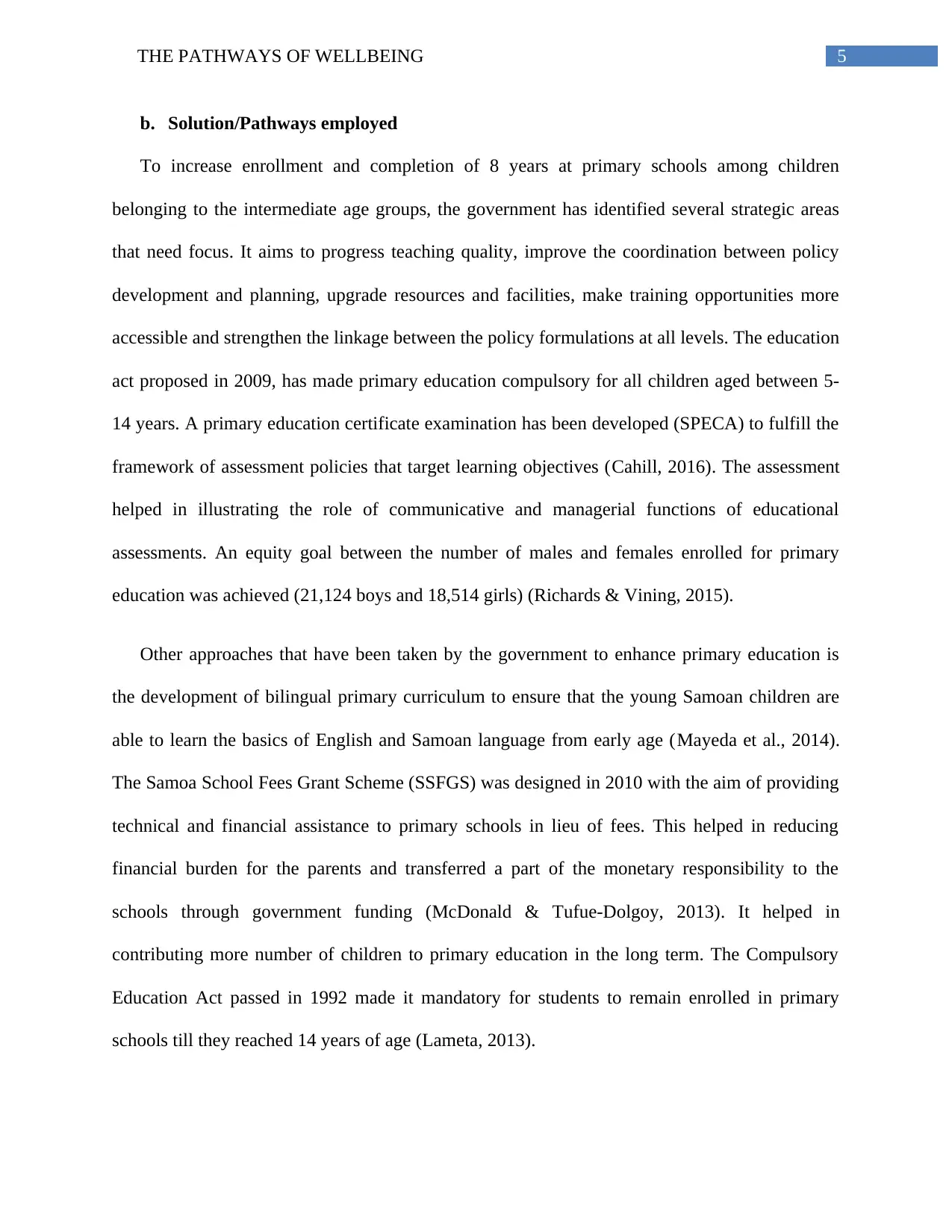
5THE PATHWAYS OF WELLBEING
b. Solution/Pathways employed
To increase enrollment and completion of 8 years at primary schools among children
belonging to the intermediate age groups, the government has identified several strategic areas
that need focus. It aims to progress teaching quality, improve the coordination between policy
development and planning, upgrade resources and facilities, make training opportunities more
accessible and strengthen the linkage between the policy formulations at all levels. The education
act proposed in 2009, has made primary education compulsory for all children aged between 5-
14 years. A primary education certificate examination has been developed (SPECA) to fulfill the
framework of assessment policies that target learning objectives (Cahill, 2016). The assessment
helped in illustrating the role of communicative and managerial functions of educational
assessments. An equity goal between the number of males and females enrolled for primary
education was achieved (21,124 boys and 18,514 girls) (Richards & Vining, 2015).
Other approaches that have been taken by the government to enhance primary education is
the development of bilingual primary curriculum to ensure that the young Samoan children are
able to learn the basics of English and Samoan language from early age (Mayeda et al., 2014).
The Samoa School Fees Grant Scheme (SSFGS) was designed in 2010 with the aim of providing
technical and financial assistance to primary schools in lieu of fees. This helped in reducing
financial burden for the parents and transferred a part of the monetary responsibility to the
schools through government funding (McDonald & Tufue-Dolgoy, 2013). It helped in
contributing more number of children to primary education in the long term. The Compulsory
Education Act passed in 1992 made it mandatory for students to remain enrolled in primary
schools till they reached 14 years of age (Lameta, 2013).
b. Solution/Pathways employed
To increase enrollment and completion of 8 years at primary schools among children
belonging to the intermediate age groups, the government has identified several strategic areas
that need focus. It aims to progress teaching quality, improve the coordination between policy
development and planning, upgrade resources and facilities, make training opportunities more
accessible and strengthen the linkage between the policy formulations at all levels. The education
act proposed in 2009, has made primary education compulsory for all children aged between 5-
14 years. A primary education certificate examination has been developed (SPECA) to fulfill the
framework of assessment policies that target learning objectives (Cahill, 2016). The assessment
helped in illustrating the role of communicative and managerial functions of educational
assessments. An equity goal between the number of males and females enrolled for primary
education was achieved (21,124 boys and 18,514 girls) (Richards & Vining, 2015).
Other approaches that have been taken by the government to enhance primary education is
the development of bilingual primary curriculum to ensure that the young Samoan children are
able to learn the basics of English and Samoan language from early age (Mayeda et al., 2014).
The Samoa School Fees Grant Scheme (SSFGS) was designed in 2010 with the aim of providing
technical and financial assistance to primary schools in lieu of fees. This helped in reducing
financial burden for the parents and transferred a part of the monetary responsibility to the
schools through government funding (McDonald & Tufue-Dolgoy, 2013). It helped in
contributing more number of children to primary education in the long term. The Compulsory
Education Act passed in 1992 made it mandatory for students to remain enrolled in primary
schools till they reached 14 years of age (Lameta, 2013).
⊘ This is a preview!⊘
Do you want full access?
Subscribe today to unlock all pages.

Trusted by 1+ million students worldwide
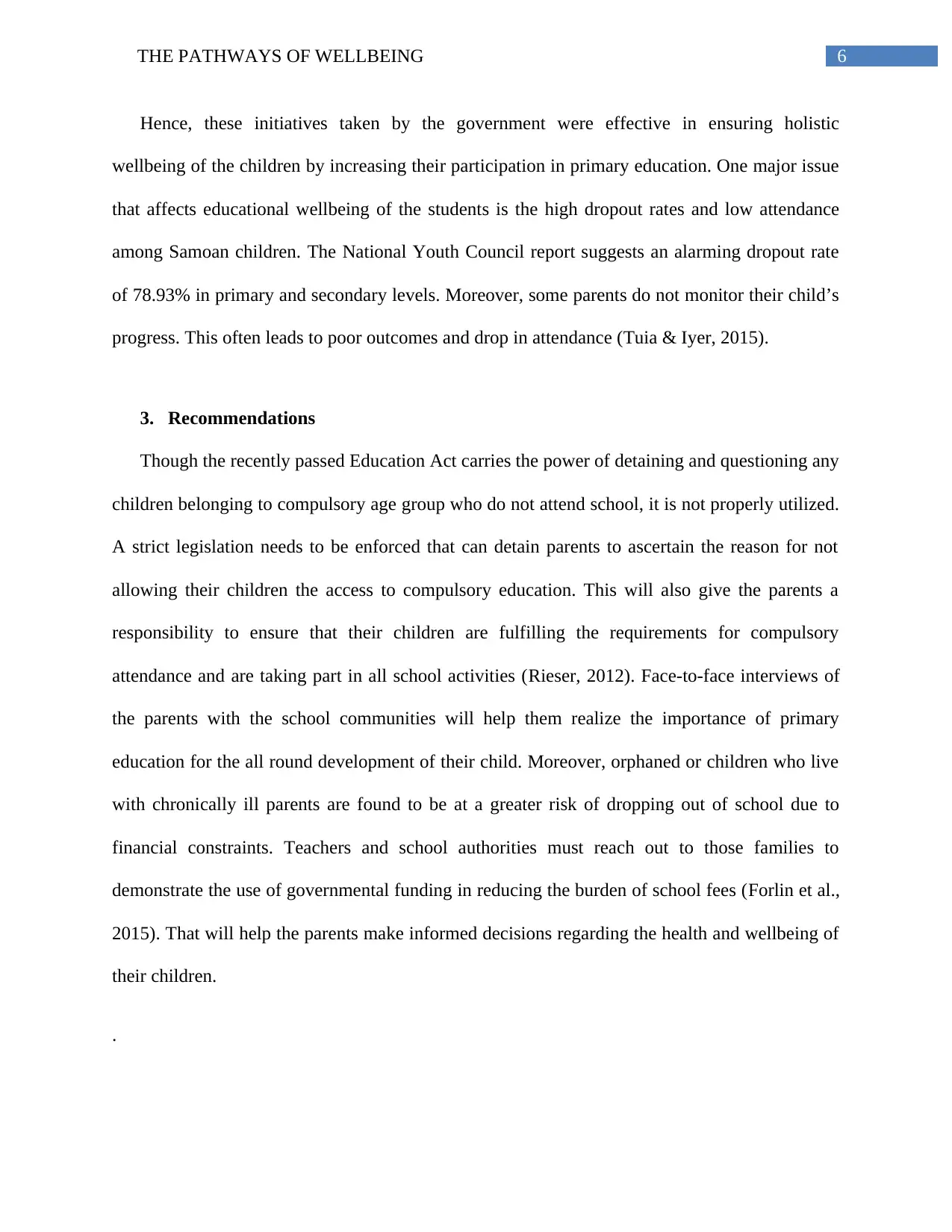
6THE PATHWAYS OF WELLBEING
Hence, these initiatives taken by the government were effective in ensuring holistic
wellbeing of the children by increasing their participation in primary education. One major issue
that affects educational wellbeing of the students is the high dropout rates and low attendance
among Samoan children. The National Youth Council report suggests an alarming dropout rate
of 78.93% in primary and secondary levels. Moreover, some parents do not monitor their child’s
progress. This often leads to poor outcomes and drop in attendance (Tuia & Iyer, 2015).
3. Recommendations
Though the recently passed Education Act carries the power of detaining and questioning any
children belonging to compulsory age group who do not attend school, it is not properly utilized.
A strict legislation needs to be enforced that can detain parents to ascertain the reason for not
allowing their children the access to compulsory education. This will also give the parents a
responsibility to ensure that their children are fulfilling the requirements for compulsory
attendance and are taking part in all school activities (Rieser, 2012). Face-to-face interviews of
the parents with the school communities will help them realize the importance of primary
education for the all round development of their child. Moreover, orphaned or children who live
with chronically ill parents are found to be at a greater risk of dropping out of school due to
financial constraints. Teachers and school authorities must reach out to those families to
demonstrate the use of governmental funding in reducing the burden of school fees (Forlin et al.,
2015). That will help the parents make informed decisions regarding the health and wellbeing of
their children.
.
Hence, these initiatives taken by the government were effective in ensuring holistic
wellbeing of the children by increasing their participation in primary education. One major issue
that affects educational wellbeing of the students is the high dropout rates and low attendance
among Samoan children. The National Youth Council report suggests an alarming dropout rate
of 78.93% in primary and secondary levels. Moreover, some parents do not monitor their child’s
progress. This often leads to poor outcomes and drop in attendance (Tuia & Iyer, 2015).
3. Recommendations
Though the recently passed Education Act carries the power of detaining and questioning any
children belonging to compulsory age group who do not attend school, it is not properly utilized.
A strict legislation needs to be enforced that can detain parents to ascertain the reason for not
allowing their children the access to compulsory education. This will also give the parents a
responsibility to ensure that their children are fulfilling the requirements for compulsory
attendance and are taking part in all school activities (Rieser, 2012). Face-to-face interviews of
the parents with the school communities will help them realize the importance of primary
education for the all round development of their child. Moreover, orphaned or children who live
with chronically ill parents are found to be at a greater risk of dropping out of school due to
financial constraints. Teachers and school authorities must reach out to those families to
demonstrate the use of governmental funding in reducing the burden of school fees (Forlin et al.,
2015). That will help the parents make informed decisions regarding the health and wellbeing of
their children.
.
Paraphrase This Document
Need a fresh take? Get an instant paraphrase of this document with our AI Paraphraser
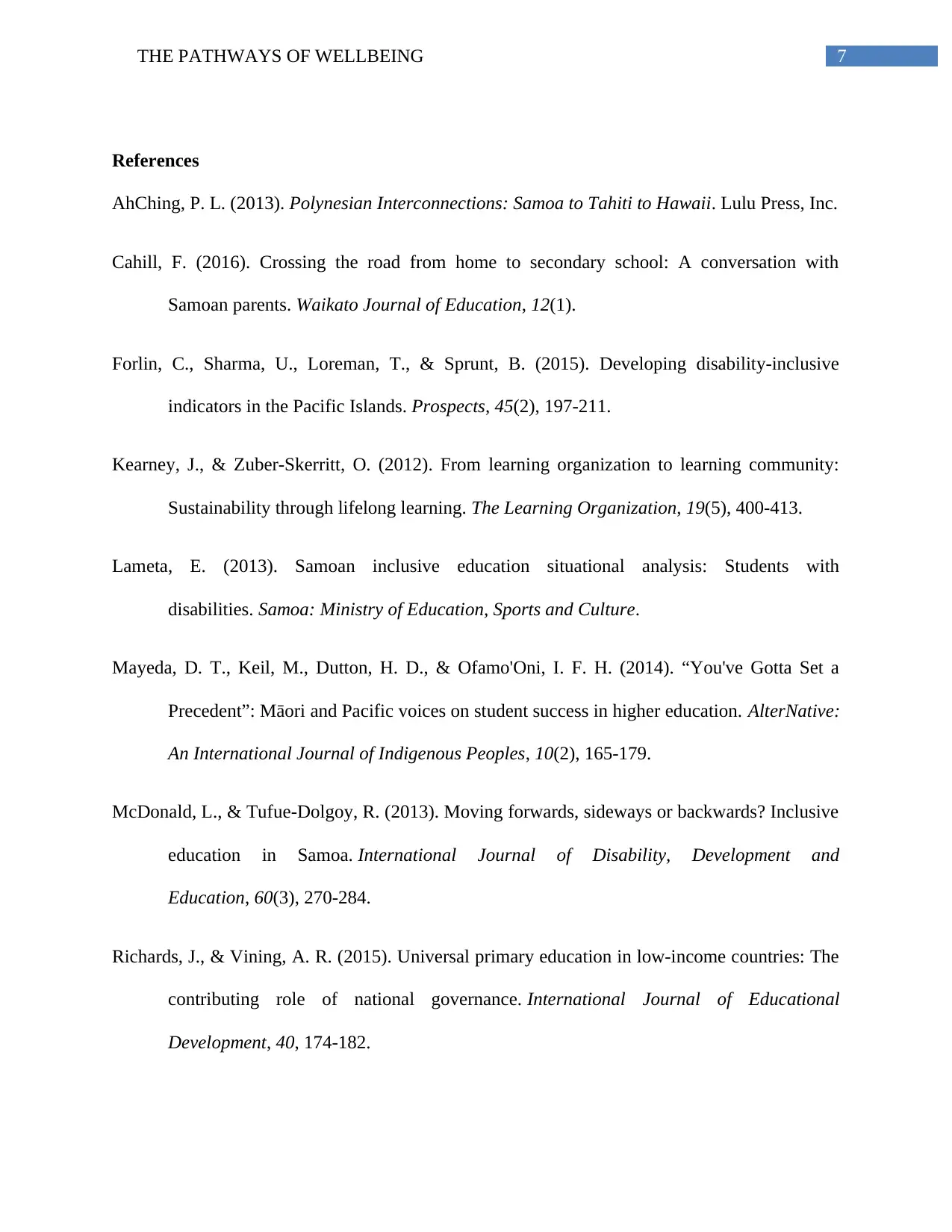
7THE PATHWAYS OF WELLBEING
References
AhChing, P. L. (2013). Polynesian Interconnections: Samoa to Tahiti to Hawaii. Lulu Press, Inc.
Cahill, F. (2016). Crossing the road from home to secondary school: A conversation with
Samoan parents. Waikato Journal of Education, 12(1).
Forlin, C., Sharma, U., Loreman, T., & Sprunt, B. (2015). Developing disability-inclusive
indicators in the Pacific Islands. Prospects, 45(2), 197-211.
Kearney, J., & Zuber-Skerritt, O. (2012). From learning organization to learning community:
Sustainability through lifelong learning. The Learning Organization, 19(5), 400-413.
Lameta, E. (2013). Samoan inclusive education situational analysis: Students with
disabilities. Samoa: Ministry of Education, Sports and Culture.
Mayeda, D. T., Keil, M., Dutton, H. D., & Ofamo'Oni, I. F. H. (2014). “You've Gotta Set a
Precedent”: Māori and Pacific voices on student success in higher education. AlterNative:
An International Journal of Indigenous Peoples, 10(2), 165-179.
McDonald, L., & Tufue-Dolgoy, R. (2013). Moving forwards, sideways or backwards? Inclusive
education in Samoa. International Journal of Disability, Development and
Education, 60(3), 270-284.
Richards, J., & Vining, A. R. (2015). Universal primary education in low-income countries: The
contributing role of national governance. International Journal of Educational
Development, 40, 174-182.
References
AhChing, P. L. (2013). Polynesian Interconnections: Samoa to Tahiti to Hawaii. Lulu Press, Inc.
Cahill, F. (2016). Crossing the road from home to secondary school: A conversation with
Samoan parents. Waikato Journal of Education, 12(1).
Forlin, C., Sharma, U., Loreman, T., & Sprunt, B. (2015). Developing disability-inclusive
indicators in the Pacific Islands. Prospects, 45(2), 197-211.
Kearney, J., & Zuber-Skerritt, O. (2012). From learning organization to learning community:
Sustainability through lifelong learning. The Learning Organization, 19(5), 400-413.
Lameta, E. (2013). Samoan inclusive education situational analysis: Students with
disabilities. Samoa: Ministry of Education, Sports and Culture.
Mayeda, D. T., Keil, M., Dutton, H. D., & Ofamo'Oni, I. F. H. (2014). “You've Gotta Set a
Precedent”: Māori and Pacific voices on student success in higher education. AlterNative:
An International Journal of Indigenous Peoples, 10(2), 165-179.
McDonald, L., & Tufue-Dolgoy, R. (2013). Moving forwards, sideways or backwards? Inclusive
education in Samoa. International Journal of Disability, Development and
Education, 60(3), 270-284.
Richards, J., & Vining, A. R. (2015). Universal primary education in low-income countries: The
contributing role of national governance. International Journal of Educational
Development, 40, 174-182.
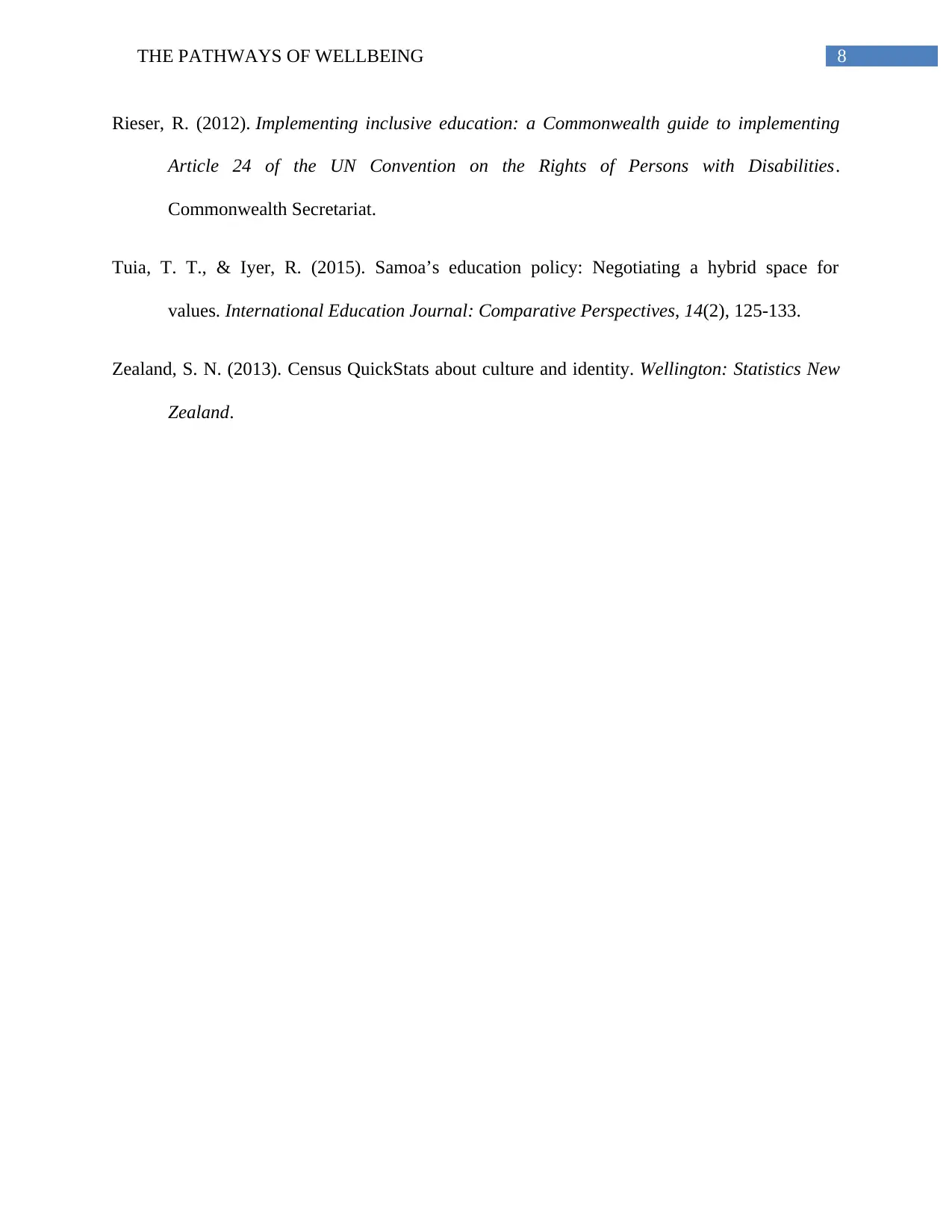
8THE PATHWAYS OF WELLBEING
Rieser, R. (2012). Implementing inclusive education: a Commonwealth guide to implementing
Article 24 of the UN Convention on the Rights of Persons with Disabilities.
Commonwealth Secretariat.
Tuia, T. T., & Iyer, R. (2015). Samoa’s education policy: Negotiating a hybrid space for
values. International Education Journal: Comparative Perspectives, 14(2), 125-133.
Zealand, S. N. (2013). Census QuickStats about culture and identity. Wellington: Statistics New
Zealand.
Rieser, R. (2012). Implementing inclusive education: a Commonwealth guide to implementing
Article 24 of the UN Convention on the Rights of Persons with Disabilities.
Commonwealth Secretariat.
Tuia, T. T., & Iyer, R. (2015). Samoa’s education policy: Negotiating a hybrid space for
values. International Education Journal: Comparative Perspectives, 14(2), 125-133.
Zealand, S. N. (2013). Census QuickStats about culture and identity. Wellington: Statistics New
Zealand.
⊘ This is a preview!⊘
Do you want full access?
Subscribe today to unlock all pages.

Trusted by 1+ million students worldwide
1 out of 9
Your All-in-One AI-Powered Toolkit for Academic Success.
+13062052269
info@desklib.com
Available 24*7 on WhatsApp / Email
![[object Object]](/_next/static/media/star-bottom.7253800d.svg)
Unlock your academic potential
Copyright © 2020–2025 A2Z Services. All Rights Reserved. Developed and managed by ZUCOL.